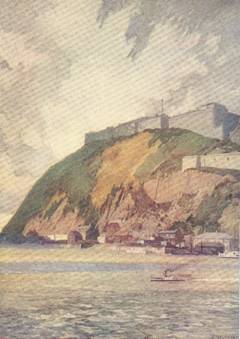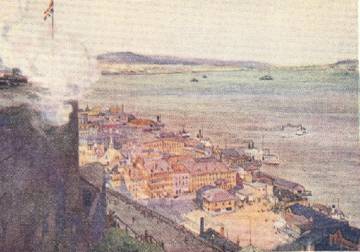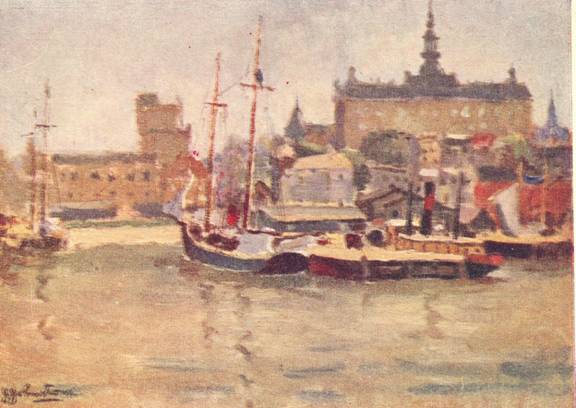
|
|
| Date Published: |
L’Encyclopédie de l’histoire du Québec / The Quebec History Encyclopedia
Quebec City
[This article was written in the 1930's and published in 1948. For the full citation, see the end of the text. Parts between brackets [...] and images were added by Claude Bélanger.] Quebec, the capital city of the province of Quebec, and one of the chief ports in Canada, is situated on a lofty rock named by Jacques Cartier in 1535 cape Diamond, at the confluence of the St. Lawrence and St. Charles rivers, 180 miles north-east of Montreal, and 800 miles south-west of the gulf of St. Lawrence. It is served by the Canadian Pacific, Canadian National, and Quebec Central Railways; and it has ferry connection with Lévis, opposite to it on the south shore of the St. Lawrence, which has here a width of nearly a mile. The origin of the name Quebec is open to doubt. It is generally believed to be derived from an Indian word meaning "The river narrows here"; but the theory has recently been advanced that it comes from an Algonkian word meaning "Place where you go back", and is in origin identical with the name of the village of Cobokonk in Ontario. It is the oldest city in Canada . It was the site of the Indian village of Stadacona, which Jacques Cartier visited in 1535, and near which he spent the following winter. It was founded by Samuel de Champlain in 1608, who built a fort (L'abitation de Québec) on the site of what is now the lower town, but who erected also in 1620 a fort on top of the rock, in which he built a wooden house, replaced in the time of Montmagny by the first stone Château St. Louis.
The Citadel on top of Cape Diamond From a painting by C. W. Jeffreys reproduced in the Canadian Magazine, Vol. 61 (1923): p. 105 During the French régime, Quebec was the centre of all movements, the headquarters of missionaries, fur-traders, explorers, and military forces in New France. During the wars between France and England, it was the scene of memorable conflicts. It was taken by the English, when still a tiny settlement, in 1629, was held by them until 1632, and was then returned to France. An unsuccessful attempt to capture it was made by Phips in 1690; and another attempt against it was made by the abortive expedition of Sir Hovenden Walker in 1711. In 1759, however, the British under Wolfe captured it after the battle of the Plains of Abraham ; and, after the cession of Canada to the British in 1763, it became the capital of the new British colony of Quebec. It was unsuccessfully besieged by the Americans in 1775-6.
On the creation of the province of Lower Canada in 1791, it became the capital of the province, and the seat of the governor-general. After the union of Upper and Lower Canada in 1841, it was for two short periods the capital of the united province. It was incorporated as a city in 1832, and it obtained its present charter in 1840.
Quebec is topographically divided into two sections, the upper and the lower. The lower town, old Quebec, with its narrow, crooked streets, suggests an ancient city of Europe. The upper town is a modern city, with wide streets and handsome public, mercantile, and residential buildings. It is reached by roads cut in the rock, by flights of steps, and by a lift or elevator. The highest point in the upper town, the crest of cape Diamond, is 333 feet above the river, and is crowned by the citadel, a strong, natural fortress with a walled area of 40 acres. From an early date there were fortifications on cape Diamond ; but the present defences were built between 1823 and 1832, at a cost of thirty million dollars. Quebec is now the only fortified town in North America.
Quebec from the Dufferin Terrace with a view of the lower town; from a painting by C. W. Jeffreys reproduced in the Canadian Magazine, Vol. 61 (1923): p. 141.
The harbour at Quebec is extensive, and can afford shelter to a large fleet. Its many wharves can accommodate 30 large steamships at a time; and its grain elevators can hold four million bushels. It is the terminal port of the Empresses of the Canadian Pacific steamships. River navigation lasts for about seven months in the year; from December to April ice prevents it, and the buoys are removed. There are two graving-docks capable of doing all necessary repair work. About three miles from Quebec is an airport, which now forms part of the Canadian airports system.
The Louise basin, port of Quebec; to the right we see the Quebec Seminary. From a painting by L. Johnstone reproduced in the Canadian Magazine, Vol. 61 (1923): p. 177. The Quebec bridge, which spans the St. Lawrence seven miles above the city, is a remarkable engineering feat. It is of the cantilever type, and has a span of 1,800 feet, with a central span of 640 feet, the longest of all metallic cantilever bridges in the world. It carries a double-track railway, accommodation for foot traffic, and also a highway. In 1907, when it was being built, it collapsed, with the loss of the lives of 75 workmen; but the Canadian government took over the enterprise, and the bridge was completed in 1917, at a cost of nearly $23,000,000. Another bridge, near Montmorency falls, connects Quebec with the island of Orleans .
Quebec has many industries. Chief among these are newsprint plants, tobacco warehouses, brickworks, foundries, tanneries, boot-and-shoe factories, clothing and corset factories, fur-trading establishments, and breweries. It is the seat of a Roman Catholic archbishop and a Church of England bishop. It has a university (Laval), a Grand Seminary for ecclesiastical students, a Jesuits' College, a famous High School, and a !junior Seminary for boys. Besides several hospitals, it has sanatoria for consumptives, asylums, and refuges. It supports three evening newspapers (Chronicle-Telegraph, Le Soleil and L'Action Catholique) and two morning papers (L'Evènement and Le journal).
Quebec has become a Mecca of the tourist. Perched on its rock like an eagle's nest-with its quaint houses, some of them nearly three centuries old its narrow, tortuous streets, its cafés, shops, and hotels with French signboards; its steep hills leading from the Lower to the Upper Town; the Plains of Abraham, now the National Battlefields Park, where the fate of New France was sealed; its historic monuments rising everywhere; churches, chapels, monastries, convents proclaiming the faith of its inhabitants; Dufferin Terrace, its unique board-walk, commanding the river; the gorgeous panorama; the proximity of the famous shrine of Ste. Anne de Beaupré and of the Montmorency falls-it draws hundreds of thousands of visitors every year. It is estimated that annually the tourist industry brings into Quebec over $6,000,000. There are many hotels; and the Château Frontenac, owned by the Canadian Pacific Railway, is one of the best appointed hotels in the British Empire . Its site-where the Château St. Louis formerly stood-is unique.
The population of Quebec is about 150,000 [for the current population], of whom nine-tenths are French-speaking.
See Sir J. M. Lemoine, Picturesque Quebec (Quebec, 1882), Maple leaves (Quebec, 1872), L'Album du Tourisme et Monographies et esquisses (Quebec, 1885); G. Mercer Adams, Illustrated Quebec (Montreal, 1891), The King's book of Quebec (Ottawa, 1911); Blodwen Davies, The storied streets of Quebec (Montreal, 1929) ; P. G. Roy, La ville de Québec sous le regime français (2 vols., Quebec, 1930), Le vieux Québec (Lévis, 1923-1931, 2 vols.), Les rues de Québec, (Lévis, 1932), Les fils de Québec (Lévis, 1933) ; William Wood and others, The storied province of Quebec (4 vols., Toronto, 1931); A. G. Doughty and N. E. Dionne, Quebec under two ,stags (Quebec, 1905); A. G. Doughty, The fortress of Quebec (Quebec, 1904), The cradle of New France (Montreal, 1908), Quebec of yester-year (Toronto, 1932) ; A. Basile Routhier, Quebec et Lévis d l'aurore du XXe siècle (Montreal, 1900); G. M. Fairchild, Jr., My Quebec scrap-book (Quebec, 1907); Geo. Gale, Historic tales of old Quebec (Quebec, 1923); Ernest Myrand, Une fête de noël sous Jacques Cartier (Quebec, 1890), Les noels anciens de la Nouvelle France (Quebec, 1899) ; E. Hawkins, Pictures of Quebec (Quebec, 1834). Source : W. Stewart WALLACE, ed., The Encyclopedia of Canada, Vol. V, Toronto, University Associates of Canada, 1948, 401p., pp. 202-204. |
© 2005
Claude Bélanger, Marianopolis College |
|


